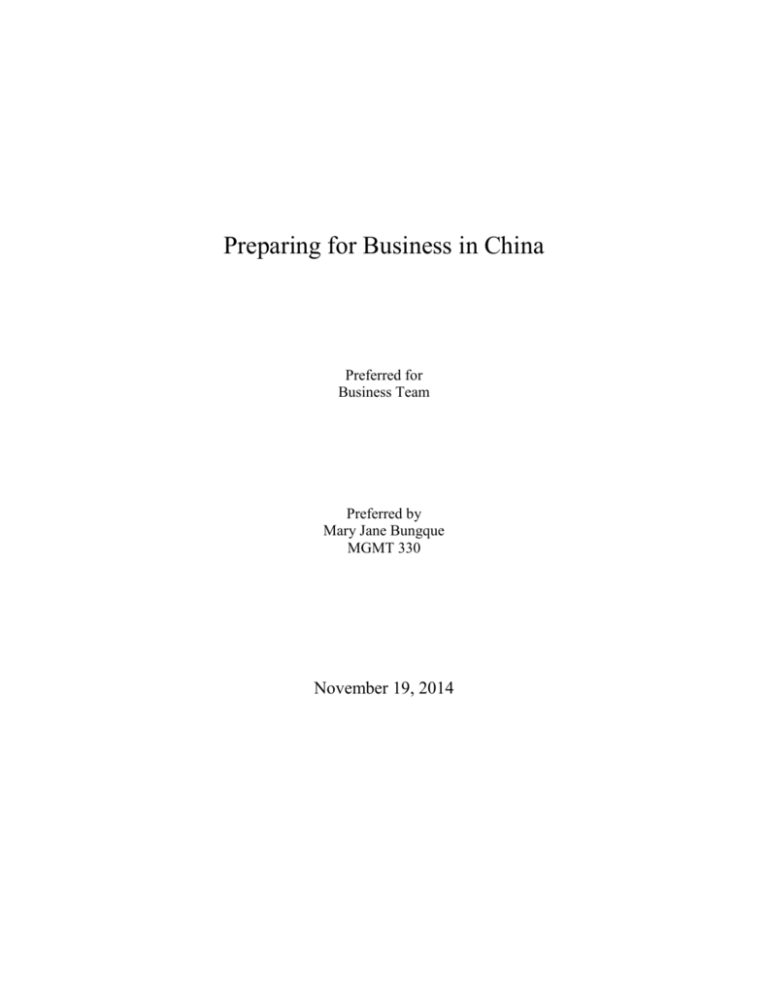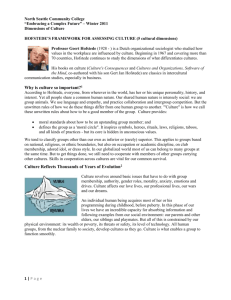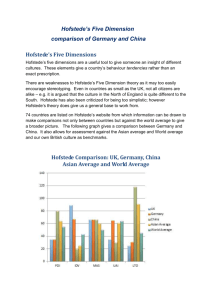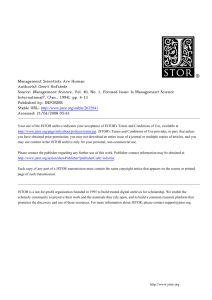Click here to my research
advertisement

Preparing for Business in China Preferred for Business Team Preferred by Mary Jane Bungque MGMT 330 November 19, 2014 Table of Contents Executive Summary …………………………………………………………………........... 1 Introduction to China……………………………………….....……………………............. 2 Everyday Living……………………………………….....………………….....………........ 2 Environment…………………………….....………………….....………….............. 2 Housing……………………………………….....………………….....………......... 2 Education…………………………………………….....………………….....…...... 2-3 Social customs and Traditions…………………………….....…………………....... 3 Business Ethics and Etiquettes…………………………………….....………….................. 3 Communication styles: verbal and non-verbal……………………………............... 3 Professional appearance, meeting and greetings……………………………............ 4 Hofstede’s Value Dimension……………………………..…………………....................... 4 Power distance…………………………………………….....….............................. 5 Individualism…………………………………………….....………………............ 5 Masculinity and Femininity…………………………….....……………..…............ 5 Uncertainty avoidance………………………………….....…………….................. 6 Long-term orientation……………………………….....………………................... 6 Recommendation……………………………………….....………...................................... 6 References………………….....……………………………………….....…………............ 7 List of Figure Figure: A – China Vs. United States Executive Summary This report will provide the group overall expectations when we move to China. Expanding our business in China will bring excellence to our Company. Our company in United States is somehow similar to the business that we are about to take over in China. This will be beneficial for our expansion of the company in China. We will base our differences by comparing both countries Hofstede’s value dimension. China is growing economically and its business is rising rapidly, this will help our business increase on its value, the customer’s satisfaction and to become more successful in the world of business. Our conclusion will be based on comparing United Stated and China’s Hofstede’s value dimension. It will also benefit us to have a proper conduct on their way of business and a brief background of the country. Formal research report broken down into major areas: China’s ways of living such as the prices of the houses, education, money, social customs and traditions, transportation and social interaction. China’s population is drastically increasing and about 1.3 billion is the current rate. Understanding and learning China’s norms will be helpful for the team. Doing business in China is intimidating since they are perfectionist. Our team will have to be consistent and lenient during work hours. It is also important to dress professional and act professional, this one way to gain Chinese leaders trust. Understanding the difference between United States and China’s Hofstede’s value dimension is important. US and China only share at least two values that are masculinity and uncertainty avoidance, the rest of the dimension are ranked differently. It is significant to know their differences. Consider on doing more research individually and share. This will help our company to be successful when we expand it to internationally, in China. As a team we need to collaborate and work as one also communication is important. This will help up build a successful, strong and long lasting relationship. 1 Introduction to China As we expand our business in China, we need to understand that thee business market has been growing for the past 30 years. Businesses from other countries such as Spain, Canada and Hong Kong are looking into China’s rapid economical, social and business growth. Our team needs to be aware that China is plays a dominant role in the world of global economy. For us, we need to understand their etiquettes in the workforce, and to adapt their cultural differences. Here are the major key points of this report. Environment, housing, education and social customs and traditions Business ethics and etiquette Hofstede’s value dimension Recommendations Everyday Living in China Environment China’s population is increasing growing and around 1.3 billion are living in the country. China’s environment has been a problem since 2008, it has emits about twice as much carbon dioxide than it should due to rapid growth of population. China is a big country that is very similar to United States and Europe. Therefore, China covers different area: north, south, northeast or western china. North central China climate is similar to Kansas United States, their weather is temperament where it snows less but more rain during winter. Hot on summer and cold on winter. South central China can be compared to the Gulf Coast State where it does not storm often but a concentrated rainfall during monsoon months, that is from late spring through summer. Northeast China is similar to Minnesota United States, there is a short warm summer and the rest is cold winter. Western China is the hottest part of China where their weather temperature can drastically change. Adapting in China’s temperature environment should not be difficult for the team. Housing China’s housing prices costs less than the United States housing. Prices in the city cost more than outside the city. Living in the city cost 3,790.63 Yuan ($600 - $700) for one bedroom, and 8,238.21 Yuan (1,300 - $ 1,400) for three bedrooms. Living outside the city with one bedroom cost 2,117.04 Yuan ($300 - $400) and 4,499.78 Yuan ($700 - $800) for three bedrooms. While Unites States has “dollars”, China has “Yuan” it is also known as “renminbi”. Here is an example of conversion: 1 renminbi is equal to 0.16 cents dollars and 1 dollar is equal to 6.12 renminbi. Due to the population growing finding a pleasant house to stay will be difficult. Conducting research on where to stay is important. Also, understanding the how the conversion works will be helpful on adapting Chinese ways of living. Education The Ministry of Education is the one who runs the public education system. China’s education is somehow similar to United States, it consist of six years of primary school, three years of middle 2 school, and three to four years of high school. Continuing into higher school such as Universities will be based on the child and parents decision. It is required that all citizen of China must attend at least nine-years of school. Government officials provide primary education for six years, and as a result parents are to pay and to let their children continue and further their education status. Chinese students are to Social Customs and Traditions Social customs and tradition in China is important. They are respectful towards other people especially the elderly. There are about seven languages that China speaks, and mandarin is their primary. They also learn English as they grow up they are taught to speak and understand the language. Chinese are particular on how they can communicate effectively with other people. They can also differentiate body language, facial expression and verbal language. Respect and trust is essential from communicating to others and to presenting their selves. In the history times, presenting their selves are distinguished by wearing different type of clothing. For poor they are to wear hemp or ramie, and for the rich people, silk. Their clothing is very restricted back in the history, but today’s fashion China is more adapted to urban styles. While western style is widely popular, China has not yet adapted its style. Another aspect is food. There are eight main regional cuisines, these are: Anhui, Cantonese, Fuijan, Hunan, Jiansu, Shandong, Sichuan, Zheijian. China has also three famous foods that can also be eaten in United Stated through the Chinese buffets. These three famous foods are Beijing roast duck, boiled sliced chicken and Chinese style steamed fish. There are also varieties of exotic food that can be eaten. In order to adopt their customs we must be willing to try to and learn their traditions and norms. This will let the Chinese community be aware that we respect their customs and norms. Business Ethics and Etiquette As said before, expanding our business in China is beneficial since China is one of the best places to do business. We have to understand that doing business in China means that we have to be consistent and lenient. There are three concepts that we need to cover. Communication styles: verbal and non-verbal Professional appearance, meeting and greetings Communication Style: Verbal and Non-verbal China’s business communication styles are both verbal and non-verbal. Today, China has maintained their record for having the most English speakers in the industry of business. Therefore the majorities of the Chinese people understand English and are able to speak fluently. In order to ensure our business with the Chinese leaders, we need to have a strong and effective communication. In other words, our team should be building on how we can understand and relate on their primary language “Mandarin”, also our Chinese team should also convey effectively and understand that “English” is our primary language. Both teams should have strong complimentary language skills that will ensure our successful business communication. Gestures, body language and facial expression will also take part an important role on how we communicate. When doing business with the Chinese, we have to ensure that each members of 3 the company has a multiple ways to contact each other. Doing this will help the company enable an effective communication style. Professional appearance, meeting and greetings China’s business attires are no different from other business countries. Men’s attires should consist of slacks, sport coats and ties. During summer men are allowed to wear opened necked shirts. For women make sure that there is no excess of heavy make-up thus dangling and gaudy jewelry that will distract others. Women should wear dresses or pantsuits, also right amount of perfume. Unlike other business cultures, China’s business meetings are different. When setting up a meeting, we must include important information and details about the meeting. As the host of the meeting it is important to arrive early to make sure that everything is set up properly, it is also important to the Chinese business culture to wait for the guest outside and escort them back to the room. Handshakes and a warm welcome greeting is a must, we also have to remember that the senior member of the business is always the first one to enter the room. Sitting arrangement varies on their rankings in the company. Before starting the business meeting there will be a short welcoming speech from the host while the servers serve the meal on the table. Both sides of the parties usually begin with short talks in order to feel comfortable. As the meeting begins, the Chinese will respond using “nods” and “headshakes”, this is their way of showing that they are listening and understanding. We need to also remember that being disruptive during the meeting is considered rude and unethical. Hofstede’s Value Dimension Hofstede’s value of dimension has five important tools that help measure and compare one country to the others. According to Professor Geert Hofstede these dimension are a guideline to analyze and generalize the guidelines for cultural differences. Here are the five dimensions: Power distance Individualism Masculinity and Femininity Uncertainty avoidance Long term orientation Below is a chart that shows the comparison in dimension of two countries, China and United States. Figure A China Vs. United States (source: China – Geerft Hofstede) 4 Power Distance Power distance deals with individuals in the societies that express attitudes of culture towards the inequalities between us. As seen in the chart (Figure A), China has scored 80 which is higher than United States. China’s society believes that it is acceptable to have inequalities among others. Their relationship is polarized and they’re no actual defense abusing from their superiors who abuse their powers. They also are somehow optimistic towards people’s initiative and leadership. Individualism Individualism is the interdependence of society; it’s the degree that maintains its member, “I” or “We”. Individualists are to look after themselves while collectivist are for groups of people. China has scored 20 on individualism, while Unites States score is higher. China is a collectivism country where people act together as a group. They are more cooperative with their colleagues inside the organization. Masculinity and Femininity Masculinity is a dimension that focuses on the society that is more driven into competition, achievement and success. While femininity focus more in the quality of life where societies care for others is high. China scored 66 whereas United States scored 62. Both countries are more masculine; they are oriented and driven, ensuring the success of their business is important than anything else. Chinese are more lenient in competition on their achievement and success. 5 Uncertainty avoidance Uncertainty avoidance deals on the future. China scored lower than United States that was 30. Chinese does not really believe that controlling the future is possible, they are more to adapt in the situation. They do not feel threatened by the ambiguity of what the future will hold or any unknown situations. Long-term orientation Long-term orientation is the dimension of Hofstede’s value. This dimension covers more on persistence, the order relationship by status and having a sense of shame. While short-term orientation steady more on personal stability, protecting your face, respect for tradition and reciprocation of greeting, favors and gifts. China scored 118, which is four times higher than United States. China sits on the high rank where they are longer term oriented. Recommendations In conclusion, China is one of the best countries to expand our business. Adapting their culture is not difficult and it should be an easy transition doing business in their country. We have to keep in mind that their business ethics and etiquettes are different to United States. Gaining their trust and respect is our main goal to be successful. Since China is a perfectionist, we really need to be consistent on what we are doing and be lenient on the business. Our business in United States will be similar but how we conduct our business in China will be different. As a team, we all have to adapt and accept cultural change. Having the ability to adapt and accept changes will make us a good team and successful. I have a list of recommendation that will help us all once we conduct or business to China: 1. 2. 3. 4. 5. Establish good relationship, firm handshake and eye contact. Be prepared for changes such as the temperature and the environment. Always be in your best professional behaviors Listen and write down notes, especially in the business meetings. Be respectful and show confidence. After conducting all the research and study about China’s everyday living, business ethics and etiquettes and their Hofstede’s value, we should be prepared and ready to take our next step. That is expanding our company business to China. 6 References Bosrcok, Mary Murray. China - Cultural Etiquette - e Diplomat (China - Cultural Etiquette - e Diplomat) Retrieved October 2014, from http://www.ediplomat.com/np/cultural_etiquette/ce_cn.htm China Education Center Ltd. Overview of Education in China - China Education Center (Overview of Education in China - China Education Center) Retrieved by October 2014 from http://www.chinaeducenter.com/en/cedu.php China Life Guide (China Life, Life in China, China Life Discovery) Retrieved by October 2014, from http://www.chinatraveldiscovery.com/china-life Forbes. The Ten Principles For Doing Business In China. Retrieved by October 2014 from http://www.forbes.com/sites/insead/2012/03/06/the-ten-principles-for-doing-business-inchina/ International, US-Pacific. How To Ensure Effective Communication With Business Counterparts In China (Business Insider) Retrived http://www.businessinsider.com/how-to-ensure-effective-communication-with-businesscounterparts-in-china-2011-2 THE HOFSTEDE CENTRE (China) Retrieved by November 2014 from http://geert-hofstede.com/china.html Numbeo. Cost of Living in China (. Prices in China. Updated Nov 2014) Retrieved by October 2014, from http://www.numbeo.com/cost-of-living/country_result.jsp?country=China 7










